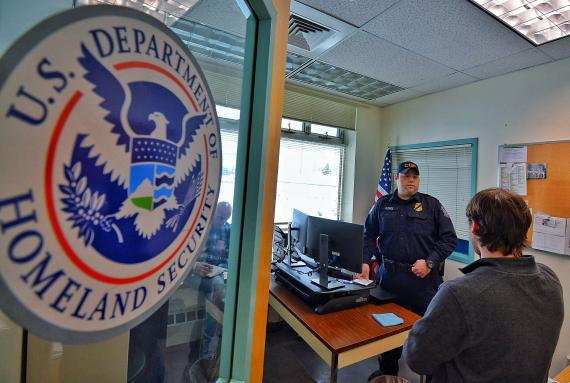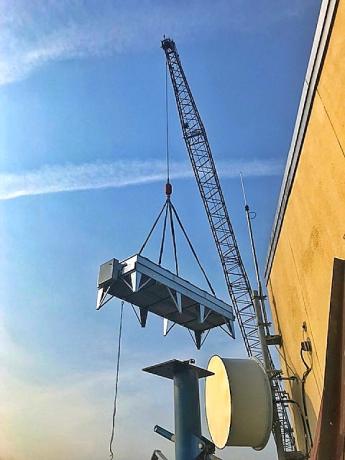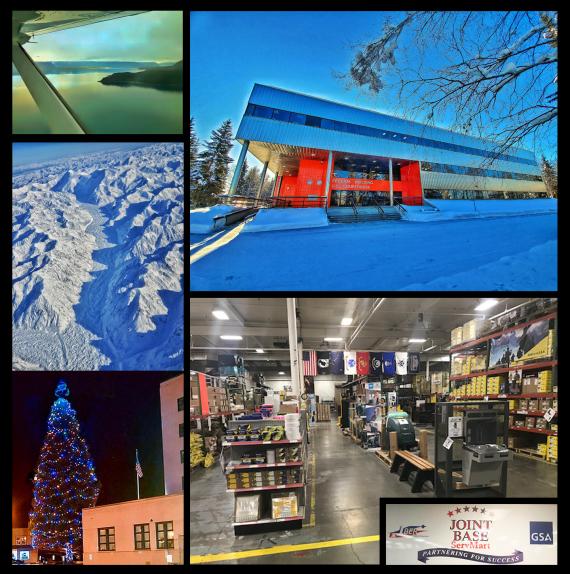Alaska: Getting the customer what they need

Story and photos by: Chad Hutson, Public Affairs Officer
Layout by: Cynthia Henry, Graphic Designer

Our Northwest/Arctic Region Building Management Specialist Steve Evans receives a cell-phone call on his way to the Alcan Border Crossing Station. They need him to bring a special part from Fairbanks to repair a broken piece of equipment.
Problem is, Evans is several hundred miles away from Fairbanks and in the middle of nowhere on the Alaskan Highway, already traveling to the border station where the part is needed. He’s frustrated. If they’d only called earlier he could have helped them. Even more frustrating, there’s no Home Depot or Ace Hardware to stop in at to get the part. In fact, there’s barely anything between him and his destination. Time to get creative.
The Northwest/Arctic Region’s team in Alaska often gets challenging and unusual requests to meet their federal partners’ needs. From a small part and an 8,000 lb. rooftop chiller, to manned cruise missile flight tests and support during the COVID-19 outbreak, GSA is called upon for all types of needs in some of the harshest environments in the world.
“There are challenges everywhere with weather, but in the Arctic region it’s difficult to find the right services sometimes to meet our requirements for our tenants because we have fewer resources available to us,” said Chaun Benjamin, Region 10 Public Buildings Service Regional Commissioner.
Once the ask for help comes to GSA from a federal agency, it can get really interesting, because now the team has to figure out how to get a product there or a contractor to the site.
The November 2019 earthquake in Anchorage shook buildings so hard that rooftop equipment on the Anchorage Federal Building needed replaced. Seems simple enough, right?

But in Alaska, getting equipment like 8,000-pound chillers to Anchorage proved to be a major challenge for GSA Northwest/Arctic Region teams. Careful and calculated coordination was required to ensure everything arrived and on time.
Unlike the contiguous United States, where products and equipment can be shipped to different destinations easily by truck or rail, Alaska poses some unique issues. The chiller unit was delivered to Seattle from Spokane, Washington, by truck, then barged to Anchorage from Seattle via ship. The 600-ton crane to lift the giant chilling unit on top of the building also had to be timed perfectly with the arrival of the chiller unit otherwise the small window of decent weather to complete the project would have been missed.
GSA got it done.
David Stone, the Store Manager for the GSA ServMart located on Joint Base Elmendorf-Richardson (JBER) in Anchorage has the responsibility of keeping the supply store stocked and ordering items for the base and surrounding federal agencies.
“We receive two barges a week, weather permitting,” Stone said. “We can always tell when one of the barges does not make it to Anchorage. The shelves start getting very bare.”
Most of the GSA ServMart store’s products arrive by barge. From there, Stone and his team have to get creative to ship products out to federal partners throughout the state.
Only a small portion of the state is accessible by road. The remaining portion is only accessible by boat or airplane. Using the state’s river systems help some remote communities receive products while others rely solely on air service.
“The limited options on getting freight out, the remote vastness of Alaska, and the lack of a statewide road system does cause the cost of living to be more expensive,” Stone added.
In addition to the store, GSA also works with the military in Alaska on some other unique projects - namely cruise missiles.
While GSA isn’t in the business of testing military equipment, they are able to find specialized businesses who can help the military with their needs. In this case, the military officials at JBER needed someone to simulate guided missile performance in the Arctic Circle. That’s not something you typically find in the yellow pages. But GSA found it for them.

“We got the opportunity to support the Air Force with this very unique mission,” said Kimberly McFall, a director with the Federal Acquisition Service for GSA. “We’ve never done this before - helping the Air Force determine how missiles perform in Arctic weather conditions.”
Much of GSA’s work in Alaska doesn’t have national security implications like that. Most of it is meeting the needs of agencies and their staff at a more relational level.
The recent COVID-19 outbreak had officials in Anchorage wondering how to handle federal building access. Kerry Long, Regional Administrator for the Federal Aviation Administration in Anchorage, also serves as the federal building’s designated official. It’s a role that allows Long to make decisions about such things as building access. He said GSA’s support and guidance was important as he was one of the first in Alaska to close a building to public access.
“I authorized a soft closing of the building to protect people,” Long said. “They know their stuff at GSA and they provided a lot of support to do this when not everyone was in agreement early on this was the right thing to do.”
From information about how to safely limit access to the building to getting regular updates on the progress of the virus in early March, Long said GSA went above and beyond to make the buildings safe for staff and general public.
“When we have a need in this building whether it’s a safety issue or changes to our space, GSA really delivers,” Long added.
Long isn’t alone in his assessment of GSA during the pandemic. Frank Sherman, Deputy Forest Supervisor for the United State Department of Agriculture Forest Service office in Ketchikan recently praised GSA staff’s responsiveness to the COVID-19 outbreak.
“Tim Garton, GSA Facility Manager, has done a great job of keeping us informed of COVID protocol changes and I would like to thank GSA’s responsiveness to our request for additional cleaning and sanitization,” said Sherman.
Jimmy Fox, United States Fish and Wildlife Yukon Flats Refuge Manager has worked at many federal locations over his tenure. Now stationed in Fairbanks, Fox has regular contact with GSA staff. He’s almost apologetic for the odd requests he’s made of GSA over the years, but adds that Fairbanks Federal Building Management Specialist Steve Evans always delivers.
From shops for welding and carpentry to storage safes for weapons to keep his staff safe from bears when they are working in the field, Fox said his Alaska operations are by far the most unique.
“Steve just rolls with it regarding our weird requests,” Fox said. “But GSA is always trying to find ways to help reduce costs while still trying to help us meet our mission.”
Back to Evans, who earlier was asked by the Alcan Border Station for a part as he was driving… he never gave up on the search. On a blistering cold morning in Tok, Evans rose with the sunrise and headed off to the only parts store in the tiny town, hoping he could find what they needed.
In the store, a traveling repairman overheard Evans’ request. He asked Evans to come to his truck with him. He showed Evans equipment parts in his truck to learn if anything he had would work.
“He didn’t have what we needed, but that’s just the spirit of people here helping out,” Evan said. “Even if that includes getting a part out of the back of someone’s truck. GSA wants you to be innovative and creative. I just love that about working here.”
Read more of the GSA “North to Alaska” series:
Part 1: Getting there and back
Part 2: Alcan Border Station, a city unto its own
Part 3: Getting the customer what they need
Part 4: We’re here - on purpose

 U.S. General Services Administration
U.S. General Services Administration